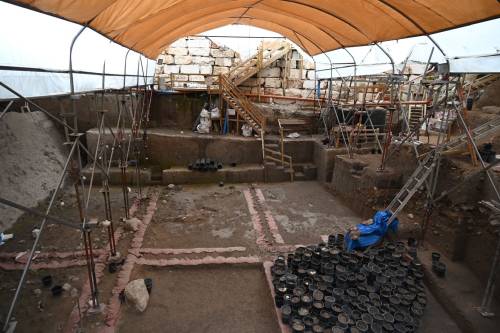A newly discovered burial site in the Negev Highlands is shedding light on trade networks in Arabia, Egypt, and beyond circa 500 BC. There are more photos here.
A cache of 26 bronze coins discovered at a Hellenistic site west of Arbel in 2016 provides insights into the Galilean military campaign of Jonathan Maccabee.
Archaeologists have deciphered a Phoenician inscription from an amphora sunk in a shipwreck off the coast of Tel Achziv around 400 BC. The inscription mentions the Sidonians. The underlying journal article is here.
According to a new study, the inability of the southern Levant to support sheep herding in the Early Bronze Age slowed the area’s advancement in agriculture and herding. The underlying journal article is here.
Excavations at Motza uncovered the Neolithic tomb of a woman with six fingers on her left hand.
The Temple Mount Sifting Project has received financial support, so they are reducing availability and increasing participation fees. They have made some new discoveries, including a Second Temple period seal and a rare Late Bronze pottery sherd.
Nathan Steinmeyer provides a brief introduction to the Negev of Israel.
A new exhibit in the departure hall of Ben Gurion airport entitled “Eternity of Israel” will include archaeological finds, some of which have never been publicly displayed before.
Bible Passages has recently begun a new blog as well as a podcast. Recent episodes have highlighted Rhodes, Cyprus, and Ephesus.
Available for pre-order: The Bible’s First Kings: Uncovering the Story of Saul, David, and Solomon, by Abraham Faust and Zeev I. Farber (Cambridge University Press, $50; Amazon). Use code TBFK2024 for a discount at the publisher’s website.
Now online: The Samaritan Pentateuch: An English Translation with a Parallel Annotated Hebrew Text, by Moshe Florentin and Abraham Tal (Open Book Publishers; free download)
Haaretz (premium) has a story about the 70-year-old Israeli reserve officer and antiquities dealer who was killed in Lebanon.
Bible Mapper Atlas has created a poster map of the tribe of Benjamin circa 1200 BC.
Kenneth Kitchen, renowned Egyptologist, died this week. Peter J. Williams’s reflections reveal what an extraordinary man he was.
HT: Agade, Gordon Franz, Arne Halbakken, A.D. Riddle
This is how the excavations at the Pool of Siloam looked yesterday. Photo by Bethany Bolen.
